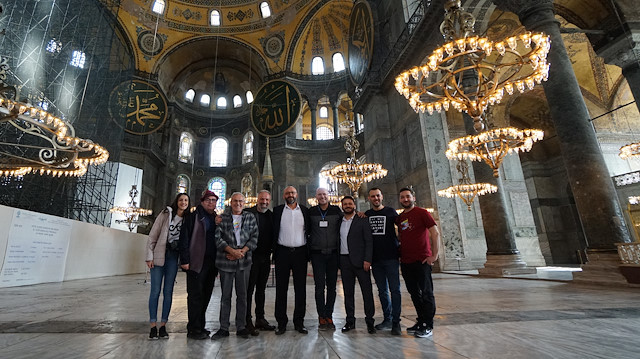

Turkish musician records Hagia Sofia acoustics
Turkish musician, singer Emre Yucelen, volunteer team behind recording inside historic building
The acoustics of Istanbul’s iconic Hagia Sofia was recorded for the first time simultaneously with eight cameras and voice recorders.
Turkish musician and singer Emre Yucelen and a volunteer team are behind the recording.
For an acoustics sound test, imam Onder Soy and muezzin Ahmet Toraman worked from a prayer room on the museum grounds and recited the Muslim call to prayer, or adhan, and other sections from the Quran inside the historic museum. A muezzin is the person who makes the call to prayer.
Dubbed the "Eight Wonder of the World" by historians, the 1,500-year-old Hagia Sophia was a Christian church until it was converted to a mosque when the Ottoman Empire conquered Istanbul in 1453 before it turned it into a museum in 1935.
A graduate of Istanbul’s prestigious ITU-Turkish Music State Conservatory’s Sound Department, Yucelen uploaded the video to his YouTube channel which has so far been seen more than 5,000 times.
This was not his first attempt to record acoustics from historical buildings in Turkey.
In 2006, Yucelen visited 17 mosques in Istanbul and interviewed religious officials for two hours and recorded their naked voice during the adhans.
- Gigantic mosques have magnificent acoustics
In 2007, he released a CD, Istanbul Mosques and Muezzins and remembers the ambiance inside those structures. “Reciting the adhan in the morning with Ali Riza Sahin Hoca in [Istanbul’s historic] Fatih Mosque on a winter evening,” he recalled. “Those leaves outside … the magnificent acoustics of that big dome.”
He said Istanbul’s gigantic mosques have magnificent acoustics and noted they were built based on reciting the adhan with a naked voice, but nowadays it is recited with a microphone.
Yucelen said he had a “classic perspective” and since he also gives singing lessons he, “really wanted to listen to the acoustics of this place.”
The recordings were made in three different locations inside the museum: under the dome, in the mihrab -- a semicircular niche in the walls of a mosque indicating the direction the faithful should face while praying, and in the muezzin mahfili, a special platform in a mosque where muezzin carries out his duties.
According to Yucelen a detailed recording like the one he did has never been done. He recalled professor Zerhan Karabiber of Istanbul’s Yildiz Technical University who did an acoustical test in the museum but it was a voice recording.
- Everyone mesmerized during recording
Yucelen recalled how everyone was mesmerized during the recording.
Should Hagia Sophia remain a museum or be returned to a mosque, as it functioned during the Ottoman era? It is a subject that has been long-debated in Turkey and Yucelen said his purpose was never to create a conflict.
“These are cultural heritage,” he said. “We are talking about architecture, a culture that has been standing for 1,500 years, and it is currently living in Anatolian lands.”
“It is a great honor for us,” he said.
#Emre Yucelen
#Hagia Sofia

